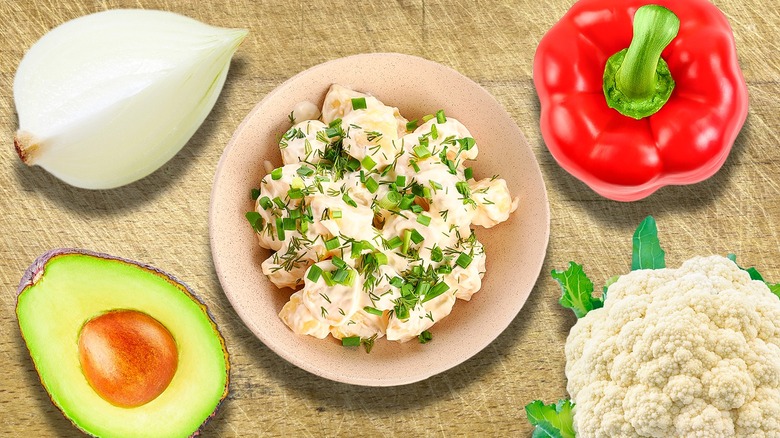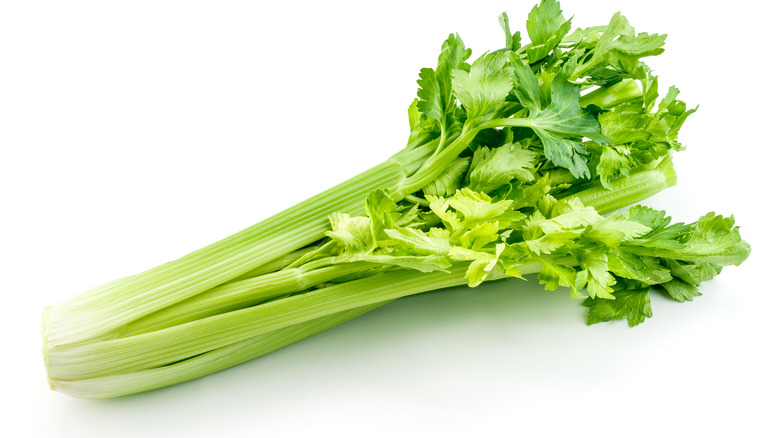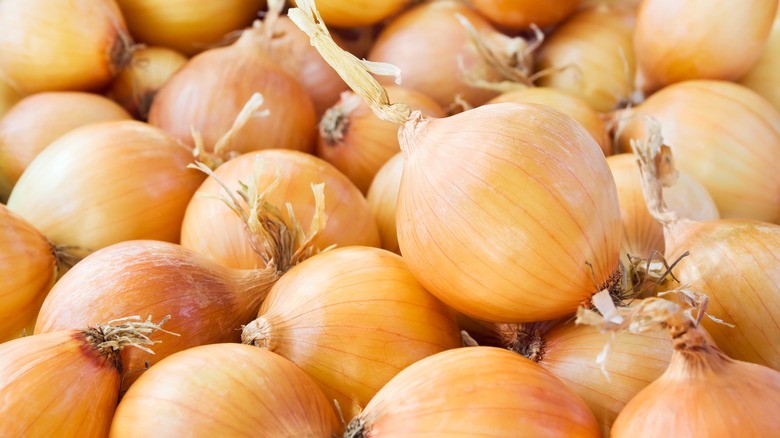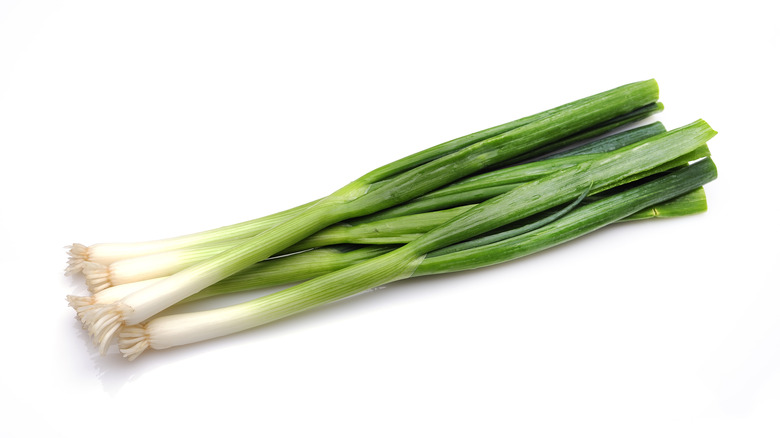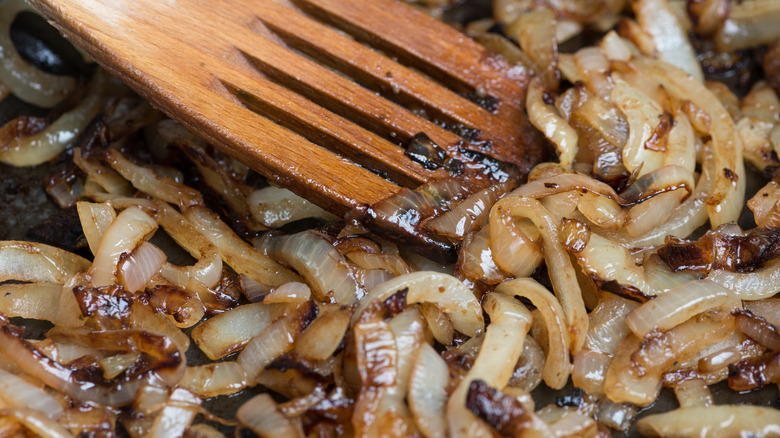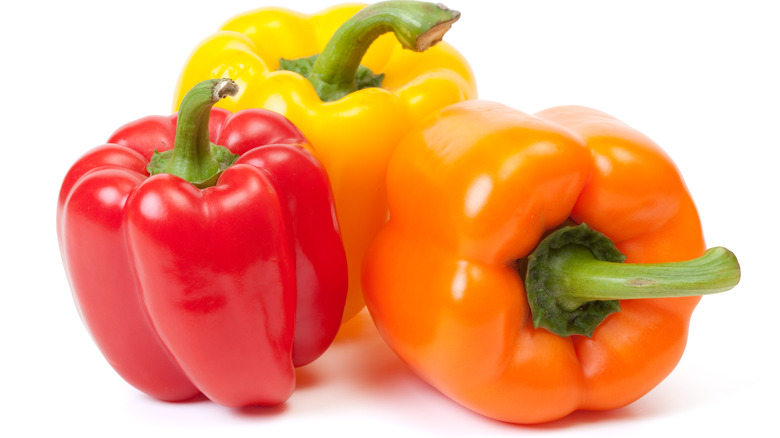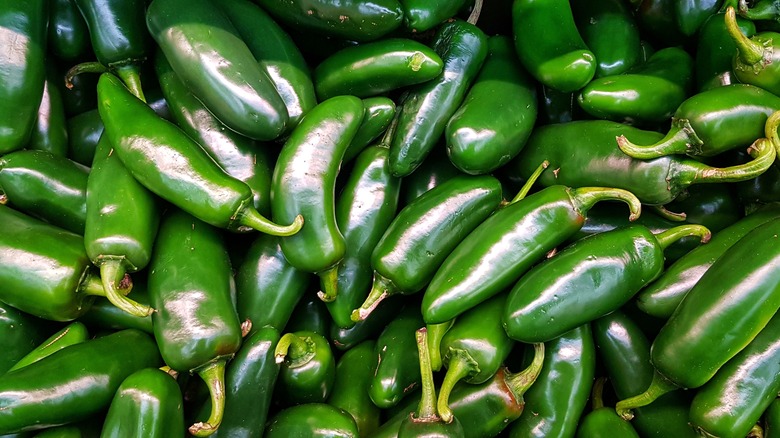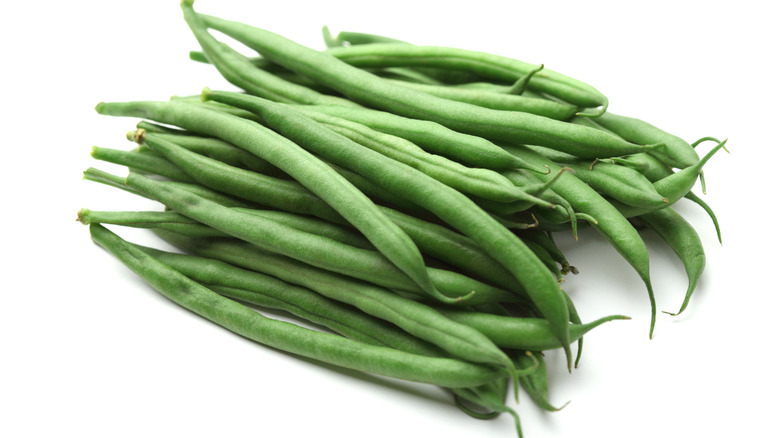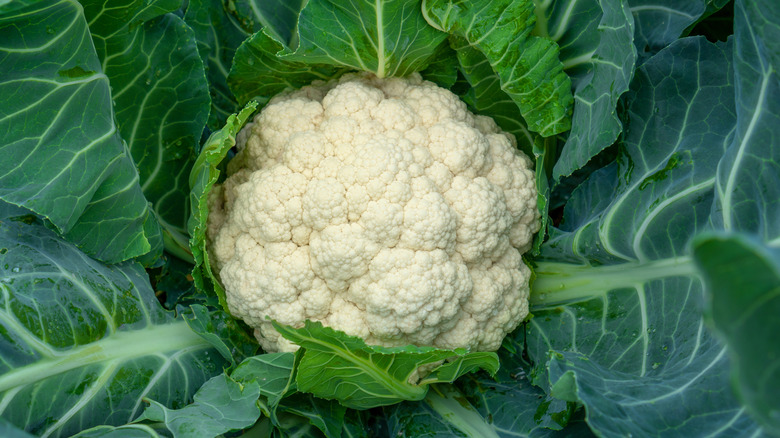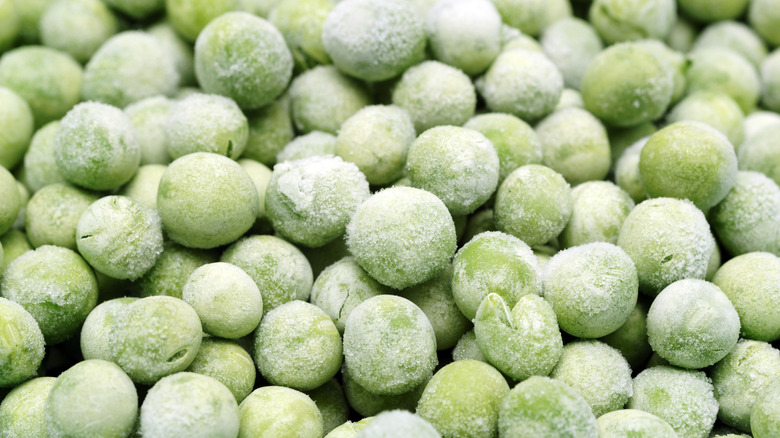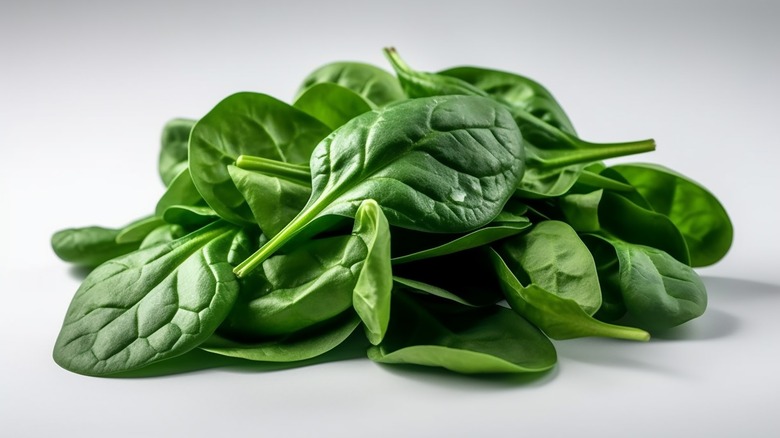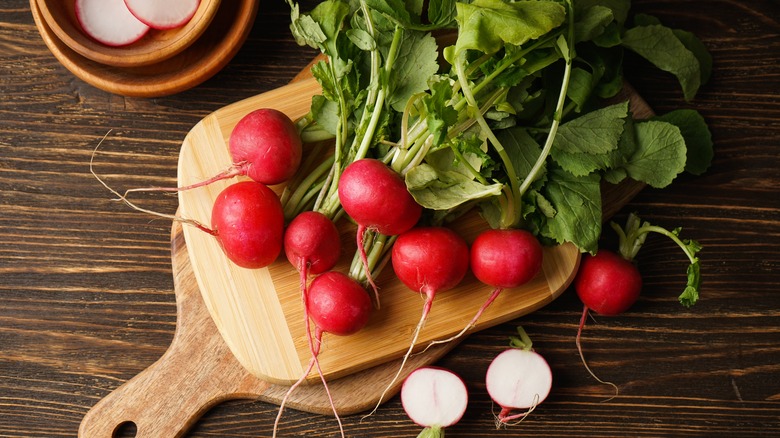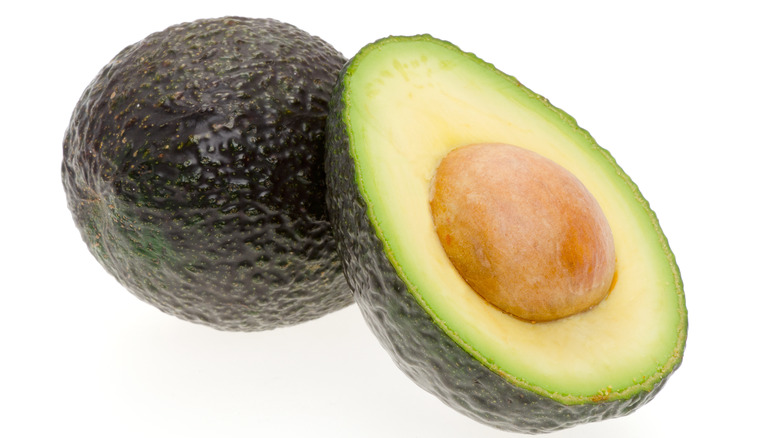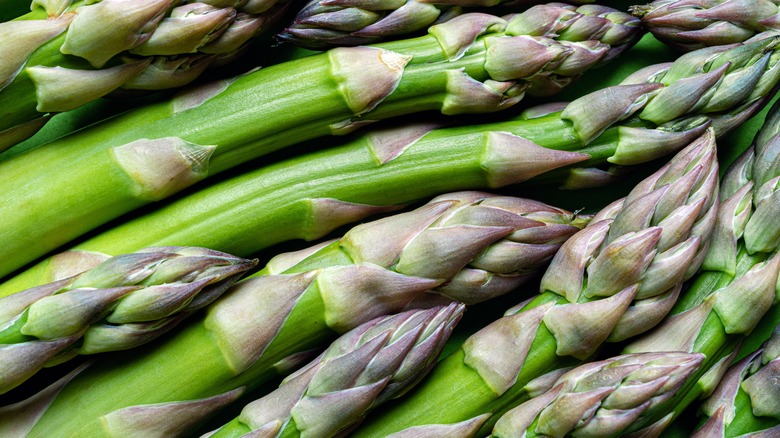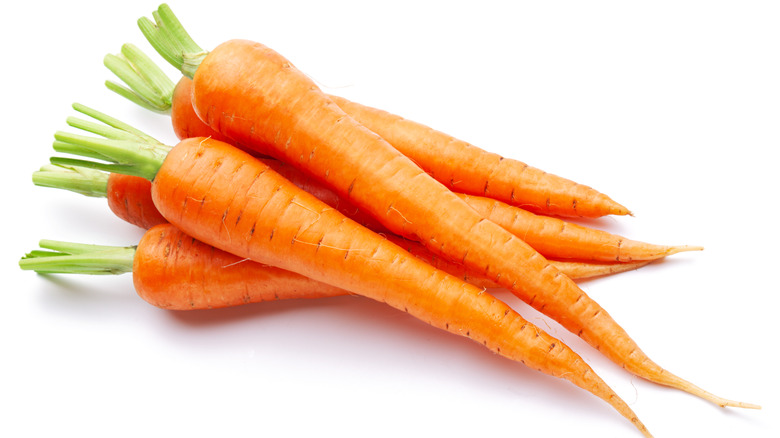14 Best Vegetables To Add To Your Next Potato Salad
When it comes to potluck side dishes, potato salad reigns supreme. Whether creamy and loaded with mayonnaise or tangy and made with vinegar, everyone has their favorite way of preparing potato salad. If you've grown tired of eating grandma's potato salad after all these years, consider shaking things up by adding different vegetables to the mix. Veggies are an easy way to change up the flavor profile and texture of your favorite potato salad without completely deviating from the recipe.
And no, the vegetables don't have to be added raw. Consider adding roasted, sauteed, or even pickled vegetables to your next batch of potato salad. Some veggies can even be boiled in the same pot as the potatoes to limit the number of dirty dishes you'll have to wash later. From sweet caramelized onions to spicy jalapeños, let your culinary creativity shine the next time you make your tried-and-true potato salad recipe.
1. Celery
If you grew up eating a classic Southern-style potato salad, you've likely added celery to your spuds before. Celery adds serious crunch and freshness to potato salad, and it stays crisp even after sitting in the dressing all afternoon. Although you can add celery to any potato salad recipe you like, it pairs especially well with mayo-based versions. The rich, heavy dressing will benefit from the pop of freshness that the celery provides.
Be careful not to go overboard on the celery, though. Just one or two stalks are all you need for an entire batch of potato salad. Opt for celery stalks that are bright in color and that smell fragrant. Discard the woody ends and rinse the stalks under cold tap water before chopping finely. If your celery has been sitting in the produce drawer for a while and has started to soften, save those stalks for a recipe where the crunch isn't critical, such as a soup or stew.
2. Raw onion
Raw onion is a welcome addition to mayo- and vinegar-based potato salads alike — in small amounts. Yellow onion has a sharper flavor than red or sweet onions, but any will work well in this dish, so feel free to use any onion you have on hand. Just be sure to thinly slice the onion or chop it very finely to avoid accidentally chomping down on a large piece later on. (And if you're super sensitive to the flavor of raw onion, place it in a fine mesh sieve and rinse with cold tap water to remove some of its harsh bite. It's not 100% effective, but it definitely helps.)
Other mix-ins that can be added to potato salad alongside the raw onion include celery and fresh herbs. The blend of flavors and textures make for a potato salad everyone will want the recipe for. If you're unsure how much raw onion to start with, use the ingredient measurements in this creamy dill potato salad recipe as a starting point. Generally, one small onion is all that's needed to amply flavor a full batch of potato salad. When in doubt, add less onion than you think necessary. You can always add more onion, but you can't take it away.
3. Green onions
Vibrant in color and mild in flavor, green onions are one of the best veggies to add to potato salad. If you often omit or reduce the amount of raw yellow onion called for in most potato salad recipes, green onions might be a good alternative for you. They deliver a distinct onion flavor, minus the pungent aftertaste.
Note that the entire stem can be used, including the dark green ends. If the green ends have started to brown or wither, discard before preparing the rest of the onion. To ensure the green onion gets distributed evenly throughout the potato salad, chop it finely before adding it to the recipe. Pro-tip: Save the last inch of the green onion's white root, as you can use up this veggie scrap by regrowing it after cutting. If adding the chopped green onion to a mayo-based potato salad, consider also including some crispy bacon bits and shredded cheddar cheese to make it taste like a loaded baked potato.
4. Caramelized onions
You might consider replacing the raw onions with caramelized onions the next time you make potato salad. This simple swap elevates any potato salad without being too overpowering. Where raw yellow onions are eye-wateringly sharp in flavor, caramelized onions are sweet and nuanced. With our foolproof caramelized onions recipe, this process takes roughly 45 minutes on the stove over medium-low heat. It's a labor of love, to be sure. However, the resulting soft and jammy texture, ultra sweet flavor, and deep brown color of the onions are worth the effort.
Yellow onions are the top choice for caramelizing, but you could also caramelize red onions or sweet onions if planning to use them in homemade potato salad. To save yourself some time later on, feel free to caramelize the onions up to around 48 to 72 hours before you plan on assembling the potato salad recipe. Let them cool before sealing them in an airtight container, then store in the fridge until ready to use.
5. Bell peppers
Bell peppers add sweetness and crispness to potato salad. Chop up any color of bell pepper you have on hand. Green bell peppers will add a subtle earthiness to the potato salad, while red will add a super sweet crunch. Yellow and orange bell peppers fall somewhere in between.
Since bell peppers have a milder flavor, you can chop them as roughly as desired before mixing into potato salad. It doesn't have to be perfect — just try to avoid getting the bell pepper seeds into the dish. Note that the bell pepper pieces will soften as they sit in the potato salad dressing. Because of that, you won't want to prep the potato salad with those bell peppers more than 24 hours in advance of serving it. After that point, it will still be safe to eat, but you might not want to serve it to guests once the peppers have lost their crunch.
6. Jalapeño peppers
Celeb chef Rachael Ray uses a blend of peppers in her potato salad, including jalapeños. To add some spice to your spuds, add one or two finely diced fresh jalapeños. You can use any color jalapeño you like, but note that green jalapeños are milder than red (although they still pack a serious punch). To ensure the potato salad isn't too spicy, remove the seeds from the peppers before dicing, because that's where they hold most of their heat — although you can certainly leave them in, if you dare!
If you don't have any fresh jalapeños on hand, canned or pickled jalapeños are a good alternative. Add the slices straight from the jar or can, or chop them finely before mixing them with the potatoes. For even more heat, you can add some of the pickling liquid to the potato salad dressing. Start with half a tablespoon, taste the dressing, and then add more as desired.
7. Green beans
Adding green beans to potato salad provides crisp texture and lots of color. For best results, trim the ends off the green beans before cutting them in half. Then place the trimmed green beans alongside the potatoes in a pot water that's been salted generously and boil for roughly 15 minutes. Alternatively, if you prefer your green beans to have some bite to them, add them to the pot when there's just 8 to 10 minutes remaining. For very crisp green beans, add them in the final 5 minutes of cooking. Green beans can also be added to potato salad raw. In that case, you'd want to chop them into bite-sized pieces to make them easier to eat.
If green beans aren't in season, frozen may be substituted. Just be sure to add them to the pot of boiling water alongside the potatoes straight from the freezer for best results. But whatever you do, avoid using canned green beans in potato salad. They're too soft and will fall apart when tossed with the potatoes and dressing. If you've never added green beans to your potato salad before, follow our classic green bean potato salad recipe to learn the basic method.
8. Cauliflower
Fresh or frozen cauliflower florets can be added to potato salad for extra texture, or you can ditch the potatoes entirely and make this low-carb cauliflower "potato" salad recipe instead. No matter which route you choose, it's best to steam the cauliflower rather than boil it so the florets retain their shape after being cooked. Steam the cauliflower florets for 5 minutes to keep them crisp-tender, or up to 8 minutes if you prefer softer florets. Then drain the florets well before adding them to the potato salad to avoid making the dressing watery.
For an entirely different flavor profile, add roasted cauliflower to the potato salad instead of steamed. Roasting infuses the otherwise bland vegetable with layers of flavor you can't achieve just by steaming it. Season the roasted cauliflower simply with salt, pepper, and garlic powder, or use herbs and spices that you think will complement the other flavors in the potato salad. For best results, stick with dried herbs and spices rather than fresh, which tend to burn in the oven if roasted.
9. Peas
Frozen peas are one of the easiest — and cheapest — vegetables you can add to potato salad. Measure out the desired amount of frozen peas, then let them hang out in a bowl of cold water on your counter for 20 minutes to thaw. Once drained, the thawed peas can be added directly to the potato salad; no need to cook them first. Frozen peas pair well with mayo-based potato salads. When you bite into them, they deliver a burst of sweetness that offsets the heavy dressing nicely.
If you're fortunate enough to have access to fresh peas, feel free to use those instead of frozen. Remove the peas from their pod and add them to the potato salad raw — or boil them for just 1 to 2 minutes to soften them slightly. However, avoid using canned peas in your potato salad, if possible. Their mushy texture and over-salted flavor are a major no-no when it comes to preparing homemade potato salad.
10. Spinach
To sneak some more fresh veggies into your potato salad, add a handful or two of fresh spinach or baby spinach to the boiled potatoes just after draining them. (Rinse the spinach under cold tap water first to remove any excess dirt or debris — you don't want that landing in your potato salad.) The spinach will wilt down once it comes in contact with the hot potatoes. The leafy green not only makes potato salad look visually more interesting, but it also adds a slight earthiness to the recipe. If you have any spinach haters in your circle, chop the spinach before adding it to the potato salad to help it blend into the dressing.
If you only have frozen spinach on hand, thaw it in the fridge overnight, and then drain well before using. If the spinach still feels wet after draining it, you'll need to pat it dry with a clean kitchen towel to remove the excess moisture. Any extra moisture will make the potato salad dressing watery and will cause it to split. It would still be safe to eat, but it wouldn't look as appealing.
11. Radishes
To add an unexpected peppery — but not spicy — crunch to your next batch of potato salad, stir in sliced or diced radishes. Chopped radishes will add a more distinct bite to potato salad, while thinner slices will blend into the dish more.
As for which radish variety to use, the options are seemingly endless. If a radish can be described as beautiful, then that honor goes to the watermelon radish, which is an heirloom variety; these radishes boast a vibrant pink inside and liven up any potato salad with their peppery flavor. Of course, the humble red radish sold at every major grocery store will work just as well as any other more unique variety.
To level up your potato salad, opt to use our pickled radishes recipe instead of fresh ones. Pickling radishes takes around 30 minutes, and you can customize the flavor profile by using different herbs and spices in the pickling liquid. If making a vinegar-based potato salad, swap some of the vinegar with the pickling liquid for an extra punch of flavor.
12. Avocado
Admittedly, avocado is classified as a fruit and not a vegetable. But since they're typically prepared and eaten like most veggies, forget that minor detail and toss one into your potato salad anyway. Cubed avocado makes for a super creamy potato salad. The alternating bites of smooth avocado and fluffy potatoes is a culinary delight that's tough to put into words.
You can also replace the gloopy mayonnaise dressing in your potato salad recipe with mashed and seasoned avocado. Mayo-free potato salad made with avocado delivers the same creaminess factor you want in this dish, but with more healthy fats and vitamins than you'd get with mayonnaise.
Another benefit to replacing the mayonnaise with mashed avocado is that it means you can leave the potato salad sitting out for longer. One of the mistakes people tend to make with potato salad is leaving it out for too long. According to the USDA, mayonnaise-based potato salad can only sit out for an hour if the temperature is above 90 degrees out, and for two hours if the weather is cooler than that. Avocado potato salad will turn brown over time, but it doesn't spoil as quickly as traditional potato salad.
13. Asparagus
Blanched, roasted, or raw — no matter how you add in-season asparagus to your potato salad, it's going to be good. If you opt to blanch or roast the asparagus, be careful not to overcook it. To blanch this spring vegetable, bring a pot of water to a boil, and then cook the asparagus for no more than 4 minutes. Blanching asparagus tenderizes it while preserving its crispness and bright green color.
To roast asparagus, drizzle it with olive oil and season with salt and pepper before cooking at 425 F for 10 minutes. Let the spears cool before chopping into bite-sized pieces and tossing them with the potato salad. Raw asparagus, meanwhile, is easiest to eat when chopped finely or shaved. Just be sure to trim the woody ends before preparing the asparagus since they're nearly impossible to eat raw.
As with all of the vegetables mentioned on this list, asparagus pairs well with any kind of potato salad. However, it's most often used in vinegar-based versions and can be served warm or at room temperature.
14. Carrots
Shredded carrots add texture galore to potato salad. Peel the carrots before shredding them with a box grater and tossing them with the potatoes, or buy a bag of pre-shredded carrots to save time. For a more prominent carrot flavor, peel and slice them into 1-inch chunks and boil them until tender in the same pot as the potatoes. Either way, they'll add a subtle sweetness to the salad.
Orange carrots are the obvious choice for potato salad, but if you can get your hands on rainbow carrots, they'll make for an even more colorful side dish. Different varieties of carrots don't differ much in taste, but it's an easy way to inject a usually one-tone potato salad with fun colors. Of course, baby carrots may also be used, but shredding them would take much longer. Because of that, adding a handful to the pot of boiling water with the potatoes is your best option.
